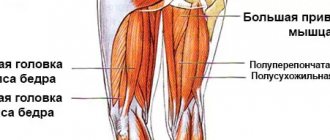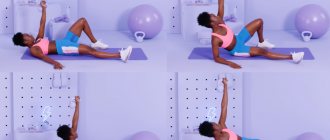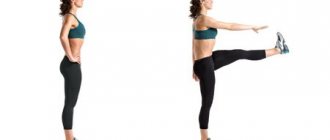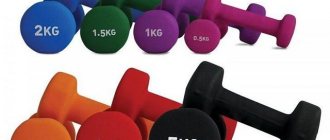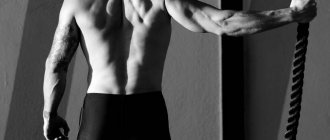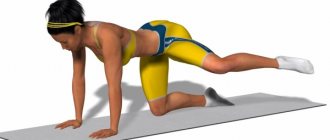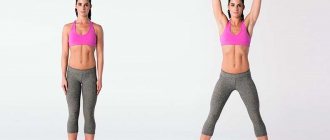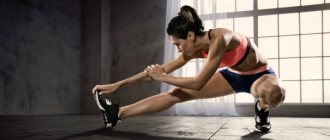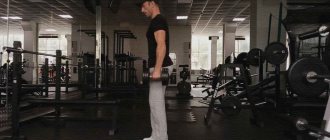Kinds
Weighting agents are fabric bags divided into sectors and filled with weight. This design fits tightly to the leg or arm. The device is secured with Velcro. In stores you can most often find the following types of weighting materials:
- With solid load (stacked). The models are made of dense canvas material, inside of which metal elements of the same weight are placed. Thanks to this, you can effectively vary the load. Another advantage is the strength of the tarpaulin, which practically does not wear out during long-term use.
- With bulk cargo. Simplified version. The base is made of fabric, and various materials are used as cargo: steel balls, sand, salt. More affordable than “hard” models. The disadvantage of soft weights is the inability to vary the loads. In addition, the woven base wears out over time, which leads to loss of filler.
In addition to standard models, there are also weighted gloves and even weight vests. For convenience, some hand accessories are produced in the form of bracelets. This option is popular among girls and beginner athletes.
Types of weights
All weights are divided into two types:
- Bulk (with sand inside). They are cheaper in price, but less practical, since their weight cannot be adjusted.
- Metal (there are metal plates inside them). This type is more expensive, but it is very convenient to use, since its weight can be reduced or added.
Depending on what part of the body the weights need to be attached to, they come in the following varieties:
- Gloves - used in wrestling to enhance the blow. Their weight reaches 12 kg.
- The belt creates a load on the whole body. Can be used during fitness activities. Weight - up to 20 kg.
- Bracelets or cuffs – attached to the ankles or wrists to create extra weight.
- Vests - Originally used by the military to increase their stamina. Over time, they became popular among people who are seriously involved in sports. Weight - up to 48 kg.
This is interesting: Tips for treating colds
Efficiency
Additional weights are used to increase loads and improve athletic performance. Let's look at the advantages of using weights:
- Intensive weight loss. Weight accessories create resistance to muscle work, which allows you to burn subcutaneous fat faster. For example, when running with weights on your legs, calorie consumption increases by 15–20%.
- Increased endurance. Along with the load on the body, the heart rate increases. As a result, the heart muscles are strengthened, and the athlete becomes less susceptible to long-term exhausting training.
- Shaping a sporty silhouette. When using weights for the lower extremities, the hips and buttocks are strengthened. When wearing wrist weights, your shoulders and back are well worked out. As a result, the muscles become toned and the figure becomes toned.
- Overcoming stagnation. Many athletes, having reached a “plateau”—the point at which progress stops—drastically change their training program in order to “shock” the muscles that have adapted. Weighted cuffs allow you to achieve the same effect with your usual exercises.
Of course, you won’t be able to pump up large amounts of muscle with weights. For these purposes, power projectiles are used. But it is possible to create additional load in aerobic training and improve results in body shaping.
Increasing efficiency
To keep your buttocks strong and round, follow these rules:
- Once every 2 weeks, supplement the complex with new exercises or change the program completely.
- Alternate stretching exercises with contraction exercises.
- Include exercises for the hip extensor muscles in your program.
- Try to constantly tense your buttocks during training, fixate at the bottom, rise smoothly, work to the maximum amplitude.
- Over time, use larger weights - 10 kg or more. The main thing is that the equipment does not suffer.
- If you work with heavy equipment, then do it 2 times a week for an hour, and if with moderate weights - 3 times for 45 minutes.
- Replenish your diet with protein foods.
- Take sports supplements such as whey protein.
Carefully! To avoid damaging your knee joints during training, use braces to support them. If you have diseases of the spine, avoid squats, lunges, and deadlifts with heavy equipment.
Weight selection
Supplement your workouts with accessories gradually. As a rule, the minimum weight of weights starts from 0.5 kg. During the first month, exercise with such weights. When the muscles get used to it, add another 500 g. Gradually you will increase the weight of the accessories to 5–6 kg, which corresponds to the loads of trained athletes.
Beginners need to first master the exercise technique under the supervision of a trainer, and only then “connect” weights.
Speed exercises, such as running, are recommended to be performed with minimal equipment (0.5–1 kg). For low-intensity elements aimed at working out muscle relief and strengthening them, you should choose weights weighing from 2 to 4 kg.
Pro Tips
Experienced bodybuilders advise starting training with basic exercises without weights, for example, squats, leg swings, etc. After improving the technique of the exercise, a beginner can use small weights, which must be gradually increased.
According to the pros, it is enough to conduct 2 to 3 classes per week with breaks of 1-2 days. You need to start each workout with a warm-up and end with muscle stretching. This will help avoid injury and reduce pain after training. Proper nutrition and sports supplements will speed up the process of building gluteal muscles.
Anton Begalko, coach
The master of sports in powerlifting believes that if the main goal of the training is pumped up buttocks, then you need to set aside a separate day to work them out. Most beginners include 5-6 movements for the gluteal muscles and 2-3 for the back and legs. According to the expert, there is no need to use many elements. 2 main exercises (8-10 sets) and 1 isolation exercise (7-5 sets) are enough. Basic movements help to work not only the butt, but also the hips, as well as the lower back.
Sergey Shelestov, coach
The repeated bodybuilding champion believes that during training you need to work all the muscles of the buttocks. To do this, the complex can include a variety of lunges, squats with weights, which train the large bundle, as well as swings, leg lifts, and stretching exercises for the development of the medium and small bundle.
According to the expert, you need to chase not the number of repetitions, but their quality. When the athlete begins to feel his muscles during training, then progress will begin. Therefore, a beginner needs to focus on technique first.
Lyudmila Kolesnikova, trainer
An experienced bodybuilder and athletic fitness champion says that if you are overweight, you need to first adjust your diet to get rid of fat deposits, and then think about training. To speed up fat burning, you need to combine strength and cardio exercises. Fat burners will help enhance the effect.
If a novice athlete has a thin physique, then you need to increase the calorie content of your diet with protein foods, focus on strength training, and also take sports nutrition with protein.
5 Effective Cardio Exercises With Leg Weights
If your goal is to quickly lose weight and tone your muscles, we recommend that you regularly perform the elements below.
Running with high knees and shin overload
We attach weights to our ankles and straighten up. Bend your arms and keep your forearms parallel to the floor. We alternately raise our knees and try to touch our palms. We move energetically, without pauses.
You can do it in one place or run around the gym. Continue for 1-2 minutes.
Then we bring our hands behind our backs and press them to our buttocks. We bend our legs one by one and try to reach our heels to our palms. We perform the overlapping quickly, for 1–2 minutes.
Climber
Place the weight firmly on your ankles and lower yourself into a plank position. The pelvis is slightly raised. Sharply pull the knee towards the opposite shoulder. We quickly return to the starting position and at the same time repeat the movement with the other knee. We move without pauses, at a fast pace, for 1 minute.
Jumping onto a plyo box
We attach the weights to the shins, stand facing the box (height 60–70 cm). We push off with our feet and jump onto the platform. When taking off, we help ourselves with a wave of our hands. Without delay, with a slight bounce back we return to the original position. Repeat for 1-2 minutes.
Jumping rope
We attach the weight cuffs to the ankles and take the jump rope in our hands. We jump for 3-4 minutes. We periodically change the jumping technique: on one leg, back and forth, with acceleration, with a double twist of the rope, and so on. The main thing is variety of movements.
Classic running
A simple and effective exercise for weight loss. In combination with additional weights, it allows you to quickly reduce fat and strengthen muscles and ligaments.
Beginners are not recommended to run with weights, as this overloads unprepared leg joints. First, you should master the technique of movements and practice acceleration and running uphill. Only after this can you gradually begin to use the cuffs.
Examples of ready-made complexes
Effective complex:
- Carrying out a warm-up.
- Cardio exercise on a treadmill. You need to run with cuffs on your arms - 25 minutes.
- Barbell lunges – 3 sets, 10 reps each.
- Lifting weights with your legs while lying on your side – 3 sets, 15 repetitions for each limb.
- Crunches – 3 sets of 20 reps each.
- Jumping rope – 5 minutes.
- Stretching exercises.
Step by step workout:
- Warm up.
- Raises with cuffs - 3 sets (20 reps each).
- Seated barbell press – 4 sets of 15 reps.
- Squats with weights – 3 sets (20 reps each).
- Ab crunches – 3 sets of 20 reps.
- Squat jumps – 1 minute.
- Breathing exercises (final stage).
Before choosing a load, it is important to assess your health status. It is better to choose the long and safe path to creating a beautiful body.
A set of exercises to strengthen the abs, thighs and buttocks
Before starting classes, do a simple warm-up: jog at an easy pace and gently stretch your muscles.
- We attach weights to our shins and stand up straight. We place one hand on the back of a chair or any other stable object. We perform swing abductions to the side. We do 20 movements and change legs. After this, we repeat the exercise with moving the limbs forward and backward. Another 20 times.
- We get on all fours, weights on our feet. Then we lower our forearms to the floor. From this position, straighten one leg and perform upward swinging movements. In the lower phase, do not lower the toe of the foot to the floor. We try not to bend the knee. At the top point, squeeze the buttocks as much as possible. Repeat 20 times and change sides.
- We stand in the “on all fours” position, the cuffs are on the ankles. Smoothly raise your right knee and move it to the side. We try to bring the thigh parallel to the floor. Slowly lower your leg, but do not place your knee on the floor at the lowest point. We perform 20 leads and change sides.
- We remain on all fours. Straighten your right leg at an angle of 45° back and place its toe on the floor. Without bending the knee, with a swinging circular motion we move the right foot behind the left, touch the floor and immediately return to the starting position. We do 20 movements, then change legs and repeat.
- We fasten the cuffs to the shins, lie on your back and bring your hips together. We keep our heels suspended. From this position, we raise our legs vertically, at the same time we push our pelvis up, taking the “birch tree” pose. We immediately return to the starting position. Repeat 20 times.
- Lying on your back, pull your knees to your chest and clasp them with your arms. At the same time, we spread the upper and lower limbs to the sides. The pose should resemble a star. We quickly return to the starting position and repeat. We make 20 dilutions.
Perform the presented plan in 2 circles. Pauses between elements are minimal - 10–15 seconds. Rest between circles - 2-3 minutes.
Before starting your workout, as a warm-up, you can use one of the cardio exercises discussed above. Complete the training by jumping rope without weights (7-10 minutes). To achieve results, exercise 3-4 times a week.
Lying hip abduction
This exercise is done in two versions. External leg abduction strengthens the outer thigh and buttocks, while inward leg abduction works the inner thigh.
- Lie on your left side, bend your right leg at the knee, foot on the floor. Extend your left leg along your body so that your right leg does not interfere with its movement. The inner side of the thigh is turned towards the ceiling.
- Fix your right knee, lift your left leg straight to the maximum possible height.
- Hold your leg in the top position and slowly lower it.
- Perform 2-3 sets with each leg.
To exercise the outer thigh in the starting position on your left side, use your right leg. It should be straightened and fixed in the knee, fingers turned forward. Raise and lower your leg slowly without sudden movements.
How to make your own leg weights
If you don't want to spend money, sew the cuffs yourself. You will need thick, strong fabric, a zipper with a lock, a Velcro strip, a metal ring and filler:
- Cut the fabric into two pieces 50 cm long and 30 cm high. Then sew them together, leaving the top edges free. It should look like a handbag.
- Sew a Velcro strip on the outside. At the same time, half of it remains free. It is the free part that will tighten the weighting material.
- Sew a ring on the opposite end from the Velcro.
- Sew a zipper into the upper sides of the “bag”.
- Divide the surface of the workpiece into several equal compartments, stitch on a machine, forming “pockets”.
- Place the filling inside and close the zipper. You can start training!
Recommendation: if you are doing weights only for the legs, reduce the height of the weight to 12-15 cm so that when applied to the lower leg it does not put pressure on the calf muscles.
Contraindications
There are diseases for which it is undesirable to train with the use of additional weights:
- phlebeurysm;
- recovery period after surgery or injury;
- muscle and ligament sprains;
- joint dislocations;
- spine pathologies;
- diseases of the cardiovascular and respiratory systems.
If health problems are diagnosed, the athlete is obliged to inform the coach, who will decide on the admissibility of using weights.
